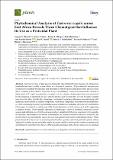| dc.description.abstract | is a plant species chemically characterized by the presence of entomotoxic rotenoids and used widely across Africa as a botanical pesticide. Phytochemical analysis was conducted to establish the presence and abundance of the bioactive principles in this species across three countries in East Africa: Tanzania, Kenya, and Malawi Analysis of methanolic extracts of foliar parts of revealed the occurrence of two distinct chemotypes that were separated by the presence of rotenoids in one, and flavanones and flavones that are not bioactive against insects on the other. Specifically, chemotype 1 contained deguelin as the major rotenoid along with tephrosin, and rotenone as a minor component, while these compounds were absent from chemotype 2, which contained previously reported flavanones and flavones including obovatin-3--methylether. Chemotype 3 contained a combination of the chemical profiles of both chemotype 1 and 2 suggesting a chemical hybrid. Plant samples identified as chemotype 1 showed chemical consistency across seasons and altitudes, except in the wet season where a significant difference was observed for samples in Tanzania. Since farmers are unable to determine the chemical content of material available care must be taken in promoting this species for pest management without first establishing efficacy. While phytochemical analysis serves as an important tool for quality control of pesticidal plants, where analytical facilities are not available simple bioassays could be developed to enable extension staff and farmers to determine the efficacy of their plants and ensure only effective materials are adopted. | en_US |

